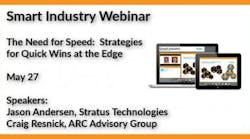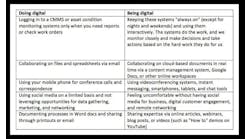What’s the best type of win?
A quick win, of course, particularly in this competitive (and chaotic) industrial environment. In a fewSmart Industry: Are quick wins at the edge really achievable?
Jason: Yes...they are for sure. We are seeing a lot of emphasis, globally, on bringing foundational IT capabilities like virtualization and security now. This has two key customer benefits. The first is they save some money with a consolidated and controllable digital infrastructure. The second is those technologies are necessary to move into more futuristic edge use cases. And while it sounds hard to do, it’s really not that bad, provided the networking is in place, which is increasing as well.
Craig: A quick win at the edge is in the area of asset-performance management—the ability to add devices to the process with low-cost sensors to predict failures before they occur. We can read values from these sensors and now add analytics at the device level. The IIoT provides the sensors, the edge provides the computing platform. We don’t have to send everything off to the cloud to be processed. We get good, local, real-time information.
Smart Industry: Can anyone in the industrial space implement these concepts?
Jason: I tend to think of what’s out there as Edge 1.0 technology; things like SCADA or historians. Oftentimes these solutions are installed in either a disconnected or lightly managed way. But with the need to feed your data and analytics tools you need to open things up and these systems are where you want to start in the industrial space. The first step is to optimize the present technology so you can pave the way for the future. We have a predominantly industrial customer base and that’s what they are doing.
Craig: It's something that can be a combination of all of this. The major companies certainly have access to all the technology and service channels to help them deploy, but at the same time, now, a small company can have this disruptive tech to apply these devices and work with system integrators who can pull together a solution. Think of Raspberry Pi...we never thought of that as a device for industrial applications, but people are mounting these $50 computers on assets to gather information and make calculations.
Smart Industry: Explain what you mean by re-engineering the supply chain.
Craig: We are now recognizing how multiple options in multiple geographies can respond in real time. This is not just something down the road, this really exploded with COVID-19. All of a sudden your supply chain from China was cut off. You had to scramble to find alternative suppliers. With real-time visibility you can know what your suppliers are doing. Having edge control gives you the ability to make real-time changes and have real-time connections to your supply chain.
Jason: Overall, supply chains are inherently complex since there’s a lot of touches and a lot of different organizations. The challenges we are seeing have to do with how your delivery capacity persists despite shrinking margins. This is the classic automation story but with a multi-organizational and multi-geographical twist. In some ways this is like the evolution of cloud technology, where standardization and data sharing will be required. So, when we think about the supply chain and what its needs are, the big question will be how can we leverage automation and software technology to increase the capacity and scale of product and material delivery.
Smart Industry: What most excites you about new capabilities with edge computing?
Jason: I am really excited about flex manufacturing and how they are using edge computing. There are so many advantages, since the compute capacity is there, to make really complex machines truly smart. Additionally, we are working with a lot of machine builders as they figure out how smart machines can also be adaptable, more serviceable and easier to operate. To me this is a big deal since the risks and costs of managing everything as a bespoke solution is no longer a good idea, particularly in the post-COVID world.
Craig: What intrigues me is how we’re bringing intelligence to almost any asset. And our ability to convert data into meaningful information at the asset level. Not just gathering data, but analyzing it to make control decisions and business decisions. We’re doing that in a real-time fashion. No latency. And that is making our business decisions more accurate.

